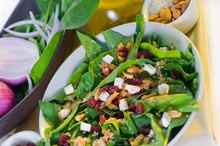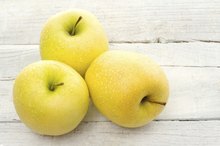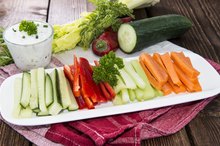What does fact checked mean?
At Healthfully, we strive to deliver objective content that is accurate and up-to-date. Our team periodically reviews articles in order to ensure content quality. The sources cited below consist of evidence from peer-reviewed journals, prominent medical organizations, academic associations, and government data.
- Medline Plus: Vitamin K
- National Institutes of Health Clinical Center Drug-Nutrient Interaction Task Force: Important Information to Know When You are Taking: Warfarin (Coumadin) and Vitamin K
The information contained on this site is for informational purposes only, and should not be used as a substitute for the advice of a professional health care provider. Please check with the appropriate physician regarding health questions and concerns. Although we strive to deliver accurate and up-to-date information, no guarantee to that effect is made.
Vitamin K in Green Beans and Apples
Vitamin K is a fat-soluble vitamin that your body uses to help blood clot and to strengthen bones. The daily adequate intake for adults over age 19 is 75 micrograms for women and 90 micrograms for men. Your body is able to make vitamin K from the bacteria in your gastrointestinal tract, but you can also get it from your diet. If you take blood-thinning medications, speak to your doctor about the amount of vitamin K you should take or if you should limit your intake, because vitamin K can affect how these medications work, according to Medline Plus 1. Your doctor may also recommend that your daily intake of food with vitamin K be consistent.
Vitamin K in Green Beans
In 1 cup of raw green beans cut into 1/2-inch pieces, there are 14.4 micrograms of vitamin K. This provides 19 percent of the adequate intake for women and 16 percent for men. Green beans also contain 12.2 milligrams of vitamin C and 690 International Units of vitamin A.
Vitamin K in Apples
Do Cranberries Have Citric Acid?
Learn More
A medium apple with a 3-inch diameter, has 4.0 micrograms of vitamin K per serving. This provides 5 percent of the vitamin K adequate intake for women and 4 percent for men. This size of apple also provides 8.4 milligrams of vitamin C and 98 International Units of vitamin A.
Vitamin K in Other Fruits and Vegetables
Other vegetables and fruit are sources of vitamin K. A 1/2-cup portion of kale contains 531 micrograms of vitamin K, while the same portion of spinach provides 444 micrograms. A 1-cup serving of blueberries or blackberries has approximately 29 micrograms of vitamin K.
Related Articles
References
- Medline Plus: Vitamin K
- USDA National Nutrient Database for Standard Reference Release 26: Raw, Green, Snap, Beans
- USDA National Nutrient Database for Standard Reference Release 26: Apples, Raw with Skin
- Vitamin A Fact Sheet for Health Professionals. NIH Office of Dietary Supplements. Updated February 14, 2020
- Sweet potato, NFS. USDA FoodData Central Updated 4/1/2020
- Spinach, cooked, from fresh, fat not added in cooking. USDA FoodData Central. Updated 4/1/2020
- Carrots, raw. USDA FoodData Central. Updated April 1, 2020
- Melons, cantaloupe, raw. USDA FoodData Central. Updated 4/1/2020
- Pepper, sweet, red, raw. USDA FoodData Central. Updated 4/1/2020
- Apricot, raw. USDA FoodData Central. Updated April 1, 2020
- Broccoli, cooked, from fresh, fat not added in cooking. USDA FoodData Central. Updated April 1, 2020
- Institute of Medicine of the National Academies. "Dietary Reference Intakes: Vitamins." http://iom.nationalacademies.org/Reports/2001/Dietary-Reference-Intakes-for-Vitamin-A-Vitamin-K-Arsenic-Boron-Chromium-Copper-Iodine-Iron-Manganese-Molybdenum-Nickel-Silicon-Vanadium-and-Zinc.aspx.
- National Institutes of Health Office of Dietary Supplements. "Vitamin A Fact Sheet for Health Professionals." https://ods.od.nih.gov/factsheets/VitaminA-HealthProfessional.
- United States Department of Agriculture, Agricultural Research Service National Nutrient Database for Standard Reference Release 28. https://ndb.nal.usda.gov/ndb/search.
Writer Bio
Stacey Phillips is a registered dietitian and nutrition writer. She has had articles and patient information handouts published in the "Renal Nutrition Forum" and the "Journal of Renal Nutrition." She holds a Bachelor's degree from the University of Illinois in Champaign-Urbana and a Masters degree at Central Michigan University.








